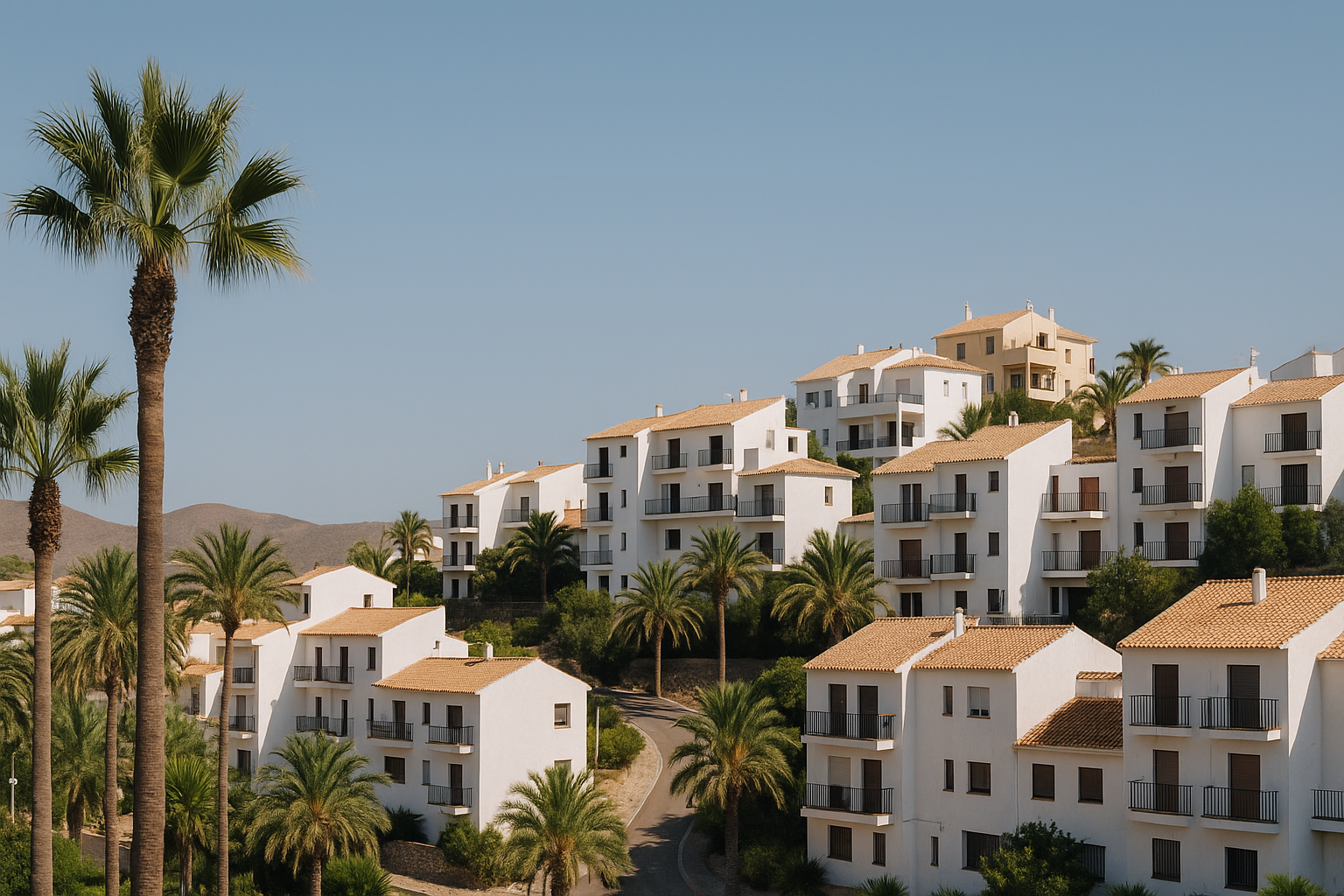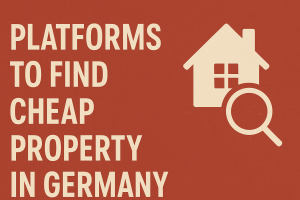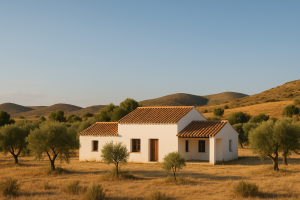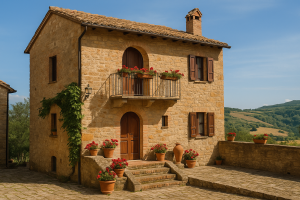Buying affordable property in Europe can be exciting and full of opportunity but it also comes with risks. From legal issues to renovation costs many buyers make the same mistakes when chasing a bargain. This guide will help you avoid the most common ones and make smarter decisions when buying property abroad.
My name is Ricardo and in 2020 I discovered how low property prices could be in some parts of Europe. While searching online I came across the Harz region in Germany where houses were listed for far less than I expected, and far less than this houses will cost int he Netherlands. That discovery changed everything. Not long after I bought my first apartment in the Harz and from that moment I became fascinated by affordable real estate in places that most people overlook.
I started Affordable Bricks to share the most interesting properties I find and to help others understand the process. That’s why want to mention that I do not sell homes and I am not linked to any estate agents. I simply post useful guides and real listings for people who want to live invest or retire in Europe without spending a fortune.
In this article you will find ten common mistakes that many people make when buying cheap property in countries like Spain, Italy and Portugal. Each point comes with practical advice and lessons learned from real experiences.
1. Skipping the Legal Check
This is the number one mistake I see people make. When a house in Spain or Italy is listed for under 50K it often comes with legal risks. Maybe the property was extended without permission or it’s on rustic land or it has old debts attached to it. In many rural areas building regulations are not strictly enforced and people often sell homes that are not fully registered.
Always hire an independent local lawyer who speaks the language and is not connected to the seller or agent. Ask them to check the following:
- Is the property legally owned by the seller
- Are there any debts or mortgages on it
- Was the home built with the correct permits
- Is it classed as urban or rustic land
- Are there shared rights or boundary issues
This legal check usually costs between €300 and €800 depending on the country. It’s one of the best investments you can make. It protects you from buying a home that you can’t renovate or even legally own.
📌 Legal situations differ from country to country Always seek legal advice in the country where you plan to buy property
2. Underestimating Renovation Costs
Many cheap homes look fine in pictures but need more work than expected. Walls may be cracked roofs may leak and electric One of the most common mistakes people make when buying cheap property abroad is not fully understanding the cost of repairs and renovations. A house that looks good in photos may have serious issues hidden behind the walls or under the roof. These can be expensive and time-consuming to fix.
In many older properties problems like damp, roof damage, cracked walls, poor insulation, or outdated electric systems are common. You may also need to install heating, replace windows, upgrade the bathroom or kitchen, or deal with structural repairs that are not visible at first sight.
Renovation costs differ a lot between countries. In places like Spain, Bulgaria or rural Italy you might pay much less than you would in France or Germany. If you have time, skills, or the right help many things can be done for less — especially if you do some of the work yourself.
From the many stories I’ve read and followed over the years one thing is clear. Renovations get much more expensive when you pay contractors by the hour. It’s smarter to find a builder who offers a fixed price for each job. This way you avoid delays and extra hours that were not part of the original plan.
Some example costs you might face
- Roof replacement €6,000 to €15,000
- Septic system repair or installation €4,000 to €8,000
- Electrical rewiring €3,000 to €7,000
- Window and door replacement €2,000 to €5,000
- Bathroom update €2,500 to €4,000
- Full renovation project €20,000 to €60,000 or more
These numbers are estimates and depend heavily on the country location size of the home and condition of the building. That is why it is always important to get several quotes before you buy and to have a clear plan before any work starts.
What i would do before buying
- Visit the property in person if possible
- Take detailed notes and photos
- Bring a builder or ask for a video survey
- Get written quotes for the work
- Avoid paying contractors by the hour
- Plan for at least 20 percent more than your estimate
Renovation can still be very rewarding. Many people turn cheap houses into beautiful and comfortable homes with the right preparation and support. Just don’t assume a €20K house only needs €5K in work. Most of the time it needs more than you expect — not less.
3. Problems Inside the Apartment Complex
When buying a cheap apartment abroad many people only look at the price and the apartment itself. The location may seem fine and the unit looks clean and ready. But there is something just as important to check before you buy and that is the building it belongs to.
In most European countries apartment buildings are managed by an owners association. In Spain this is called a comunidad and in Germany it is called Eigentümergemeinschaft. These groups take care of shared spaces like the roof stairwells pipes lifts and exterior walls. They also collect monthly or yearly fees from every apartment owner to pay for this.
This is where problems often begin.
Some buildings have not been maintained for years. Things like broken windows old pipes or roof leaks are ignored. When repairs are finally needed the cost is often shared among all owners. This can lead to one time payments that cost several thousand euros per apartment even if your own unit has no damage.
Another common issue is poor management. If the association is badly run you may face delays poor communication or surprise costs. Some buildings also have many owners who do not pay their share or who are never present. This creates financial problems that affect everyone else.
What to check before buying an apartment
- Ask for recent meeting notes from the owners group
- Request a full breakdown of yearly service fees
- Check if major repairs are planned in the next year
- Look at the condition of common areas like stairwells and roof
- Ask if there are unpaid debts or legal issues within the group
- Be careful if the service fees are very low as this often means no maintenance is done
If you cannot get this information from the agent or seller it is a warning sign. A cheap apartment may look like a good deal but if the building is in bad shape or badly managed the real cost can be much higher later on.
Understanding how the apartment complex is run will help you avoid problems and choose a property that is not only cheap to buy but also stable to own.
4. Overlooking Structural Issues
One of the biggest risks with cheap homes is hidden structural damage. These problems are often not visible at first glance especially if the property looks clean and well presented. Many buyers walk through the house in ten minutes and assume everything is fine because it feels solid. But looks can be very misleading.
Cracks in the walls or ceiling are easy to ignore if they are small. Some sellers even paint over them just before viewings. But these cracks can be a sign of serious problems like foundation shifts or water damage. In certain regions homes were built quickly with poor materials and over time the land beneath them moved due to erosion rain or poor drainage. This can cause one side of the house to sink or lean.
Floors that slope or feel uneven might also signal deeper issues. Sometimes the subfloor has rotted away or the supporting beams are weak. You might also notice doors or windows that do not close properly or frames that feel crooked. These are all small warnings that the structure may not be stable.
Roof damage is another major issue especially in older buildings with wooden beams or heavy tiles. A roof that looks fine from the ground might have cracked tiles soft wood or missing insulation. You may not see a leak during dry weather but once the rain starts it can cause major problems like wet ceilings mold and rotten frames. Repairing or replacing a roof can cost more than the house itself in some cases.
Also look at the foundation if possible. In some countries homes are built without a deep base especially in rural areas. This can lead to major movement over the years. Trees nearby can also affect the ground by drawing moisture and causing soil shifts.
Before you buy a cheap property always take time to inspect every room carefully. Look at the corners of ceilings and floors check around windows and behind furniture for signs of cracks bulges or stains. If anything feels soft under your feet it could be water damage or rot. Or If the walls sound hollow or the tiles feel loose it might be more than just bad finishing.
If you are serious about a property it is smart to bring someone with building experience even if you have to pay a small fee. A local builder or renovation expert can usually spot problems in minutes that a buyer might miss. They can also give you a rough idea of what repairs might cost and how difficult they would be.
Fixing structural issues is not like painting a wall or replacing a tap. It often needs permits heavy work and skilled labor. It can take weeks or months and cost thousands. In some cases the damage is so deep that the house becomes unsafe or not worth saving.
Knowing what to look for gives you power. It helps you avoid a property that turns into a financial trap. Structural issues do not mean you should walk away from every old home but you should go in with your eyes open. A cheap house is only a good deal if the structure is sound or if you are fully prepared for the work it needs.
5. Missing the Warning Signs of Moisture and Drainage Problems
One of the biggest risks when buying an old or rural home is moisture. Water damage is silent and slow but it can destroy the value of a property over time. It weakens walls damages wood brings mold and in some cases leads to long term health risks for the people living inside.
Drainage is a key part of this problem. Many homes in cheap areas were built decades ago without modern systems to guide rainwater away from the house. This means that over time water builds up around the foundation and slowly seeps in through cracks and walls.
A home may look dry during summer but everything changes when the rains come. Flooded basements wet plaster damp corners and swollen wooden floors are all signs of poor drainage and hidden water paths. These issues are not just cosmetic — they often mean structural repairs will be needed later.
Always inspect the exterior of the house. Check if the land around the home slopes away or toward the building. If water runs toward the walls during rain it is a major red flag. Gutters should be present and in working condition with proper downpipes that carry the water far from the house. If there are no visible drains or if you see signs of pooling water near the foundation the property might be at risk.
Inside the home take your time in every room. Look at the lower corners of the walls behind cabinets and under stairs. If you see bubbling paint stains patches of mold or smell something musty it often means moisture is trapped inside. Sometimes sellers clean and paint over these signs just before a sale so be alert.
Basements and crawl spaces are common problem areas. If the home has a cellar check the walls and floor for salt stains green patches or soft crumbling concrete. These are all signs of ongoing moisture problems.
If possible try to visit the home during or just after rainfall. This is when problems reveal themselves. You may see leaks water paths or large puddles that are not visible on a dry day. If that is not possible ask neighbors about water levels in the area and whether the property or street has flooded in the past. Local people often know the history better than agents or sellers.
Solving drainage and water problems can be expensive. It may require exterior digging and sealing installing French drains fixing the roof or even redoing the entire foundation in bad cases. Some moisture solutions seem cheap but only mask the problem instead of solving it.
That is why it is better to avoid these issues if possible or at least go in with full knowledge. A beautiful home that feels fresh in the summer sun might hide a wet dark and unhealthy interior once winter comes.
Knowing the warning signs of moisture helps you avoid disaster and keeps your renovation budget safe. Always check before you buy.
6. Buying Without Checking Access Rights
When looking at cheap property especially in rural or hillside areas many buyers focus only on the house itself. But access is just as important. A home may look perfect but if you cannot legally reach it by car it becomes a problem that is hard to fix later.
In many parts of Europe older homes were built before modern planning rules. People used local dirt roads farm tracks or even narrow paths to reach their homes. In some cases these roads cross land that still belongs to neighbors or the state. If this access is not officially registered you may not have the right to use it even if the road has been used for years.
You might not notice this during a visit. The road looks normal and the agent may not mention any issue. But after the sale you could find out that your neighbor controls the only path to your door. They might allow access at first then block it later or demand money to keep using it. In some cases you would have to go to court to prove your right to pass. These legal battles can take years and cost far more than the house itself.
Access problems are more common in hilly or remote areas where roads are narrow and land ownership is complex. This also includes driveways that pass through shared land or public paths that are no longer maintained.
Before buying always ask your lawyer to check that your access is legal registered and permanent. They should look at the land registry maps and confirm that you have full vehicle access from a public road. A road that is only marked as a footpath is not enough. Also check if your access crosses someone else’s property and if there is a written agreement for that.
Never assume that just because a road exists you can use it. And never rely only on the word of the seller or the agent. Access issues are a real threat to rural properties and ignoring them can ruin your plans completely.
7. Not Researching Natural Risks
Cheap properties are often located in areas with hidden risks that most buyers do not check. A beautiful house near a river or forest might seem peaceful but the reason it is cheap is often linked to natural dangers like floods landslides wildfires or earthquakes.
If the house sits at the bottom of a slope heavy rain can cause mud or water to flow toward the home. Or If it is near a dry riverbed it might flood during storms. If it borders thick forest it could be at risk during dry seasons when wildfires spread quickly. And if it is in a known earthquake zone the structure needs to be built in a way that can handle movement.
Many buyers do not take the time to research this. They trust the photos and focus only on the price. But once disaster strikes or even if damage happens slowly over time insurance becomes expensive repairs add up and sometimes the property becomes hard to sell again.
To protect yourself check satellite maps and government websites that show hazard zones. Some countries have open access to these tools and you can see where flood plains or fire zones are located. If you are unsure talk to people in the area and ask if they know of past events or risks.
Also inspect the building for signs of previous water damage erosion cracks or ground movement. Nature leaves clues. If you see marks on the walls or slopes pushed toward the house these are warnings you should not ignore.
Understanding natural risk is part of buying smart. A cheap home in the wrong location can cost you more than a safe home with a slightly higher price.
8. Buying Without a Long Term Plan
Many buyers fall in love with the idea of owning a house abroad. The price is low the photos are nice and the dream feels close. But they forget to ask a simple question — what is the plan after the purchase?
Some people want a holiday home others dream of early retirement or living part-time in the sun. Some want to rent it out while others see it as a long term investment. Without a clear goal it becomes easy to buy the wrong property in the wrong place.
If you want to rent the house check if the area has tourist demand and if short term rentals are allowed. Or If you want to live there full time think about the seasons lifestyle and services. If the home is meant to be a quiet escape ask yourself if the travel time or upkeep still makes sense in five years.
It is also important to look ahead. Will you need internet for remote work Will you want to renovate and increase the value Will the area grow or shrink in the coming years
Many buyers later regret their choice not because the house was bad but because they never thought about how it fit into their life. A cheap home becomes expensive if you cannot use it the way you hoped.
Think beyond the moment. Picture your life in that space a year from now or five years later. Make sure the location home and lifestyle match your plans and not just your budget. When you buy with purpose every step becomes easier and your investment has a much higher chance of success.
9. Skipping the Local Area Research
Many people fall in love with a cheap house and forget to look at the area around it. But the local environment matters just as much as the property itself. A house is not just a building — it’s where you live shop eat rest and build your daily routines. If the area around it is not suitable it can quickly become a regret.
One of the most important things to check is population trend. Some rural areas across Europe have been losing people for decades. Villages that once had schools post offices and active town squares are now mostly empty. If the population continues to decline services disappear and life becomes more difficult. Buses stop running shops close down and the local doctor might only visit once a week.
Even if you are happy with peace and quiet you still need basic infrastructure. A supermarket within driving distance a working internet connection and access to healthcare are not luxuries — they are essentials. You also want to know if there is crime in the area or if squatters are common in empty homes nearby. These are not things you can see from a photo or short visit.
Another thing many buyers overlook is the social life. Some villages have active communities where people help each other and stay connected. Others are more closed especially if most of the original residents have left. You may find yourself in a place where the only people left are weekend visitors or foreign retirees. This is fine if that fits your lifestyle but it can feel isolating if you hoped to integrate and live like a local.
In some regions there are villages made up almost entirely of foreigners. British Dutch and German buyers often settle in the same towns. That can make things easier at first but over time it may feel less like Spain or Italy and more like a gated expat zone. If you want to learn the language connect with locals and enjoy the real culture this setup may not be what you are looking for.
Also pay attention to noise levels and daily rhythms. Some towns have festivals that go on all night while others turn into ghost towns after dark. Try walking around at different times of day. See who is out and what kind of people live nearby. Are there families working locals older people or is it mostly empty rental homes?
Before you buy spend at least a few days in the area. Rent a place nearby. Visit the town square sit in the local café watch how people interact. Are they friendly do they smile or do they ignore outsiders? Try using the local services like bakeries markets or buses. See how it feels to live there even just for a short while.
Local Facebook groups and forums can also be helpful. Ask honest questions and see what long-term residents say. Some people will tell you directly if a village is declining or if there is tension between locals and newcomers. These small signals help you avoid disappointment later.
Buying a home in the wrong area can lead to years of regret even if the house was a great deal. Take your time. Research deeply. Make sure the area fits your lifestyle goals and not just your budget.
10. Relying Only on Online Listings
Many buyers focus only on big sites like Idealista or ImmoScout and never go deeper. But some of the best and most affordable properties are sold through smaller local websites town boards or even word of mouth.
Local agents often have listings that are not online or only in the local language. If you only search in English you miss many options. Prices may also be higher on international sites compared to local channels.
Once you choose a region start checking local sources. Join Facebook groups and forums. Use Google Translate to search in the local language. Ask people in the area if they know about any properties for sale.
This takes more effort but helps you find better deals and more realistic prices.
💬 Join the Conversation
Looking for advice or want to share your experience? Our community forum is the place to ask questions, learn from others, and connect with people across Europe who are also searching for affordable property. Whether it’s about financing, notaries, or renovation tips. You’re not alone. Your story might help someone else too!



